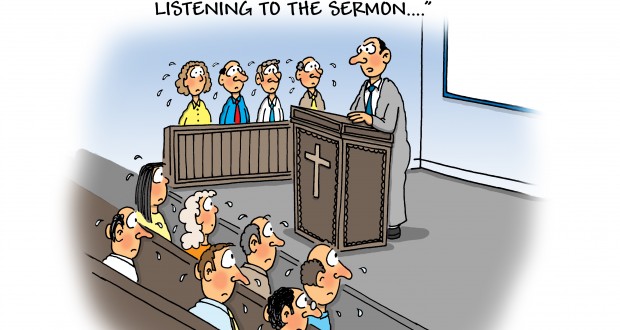Pull out the popcorn, it’s time for the sermon. Dianne Jensen explores how preaching styles have changed, and why good preaching still matters.
When comedian George Burns suggested that the secret of a fine sermon is to have a good beginning and a good ending, with the two as close together as possible, he could not have imagined the entertainment provided by the modern preacher.
Puppets, drama, videos, storytelling, interactive dialogues and Lego people portraying biblical characters are just some of the creative tools used by the contemporary preacher.
For those with memories of what Victorian novelist Anthony Trollope described as “that anxious longing for escape” on Sunday mornings, the changes are like a fresh breeze.
Others, confronted by technological wizardry and expectations outside their comfort zone, may depart from a worship service feeling less than satisfied.
It’s in our genes
Preaching—both ordained and lay—is in our nonconformist DNA. The Congregationalist, Methodist and Presbyterian traditions, which came together to form the new pilgrim community of the Uniting Church in Australia, were firmly rooted in the importance of preaching the word.
The Basis of Union, the Uniting Church’s foundational document, sets out the conviction that through the power of the Holy Spirit, through human witness in word and action, God’s message of salvation and redemption is made known to the world.
And in spite of changing times and different expectations, preaching still matters to Uniting Church congregations.
The National Church Life Survey (NCLS) 2011 Uniting Church profile showed that 52 per cent of respondents agreed that the preaching at their church was usually very helpful, with only two per cent saying that it was rarely or never helpful.
Rev Dr Malcolm Coombes, principal of Trinity Theological College, believes that while we shouldn’t limit our witness to what happens in a sermon, good preaching continues to have an important role.
“It is partly through preaching that we can command people’s attention and awaken faith when it is in the power of the Holy Spirit,” he says. “It is through preaching that people can be called to be disciples. It is through preaching that people can be encouraged in their living in faith.”
Pushing the boundaries
There is nothing wrong with doing things differently, believes Dr Coombes; in fact, it is essential.
“The shape, form, style, and content of preaching need to be constantly questioned in the light of changing society. It always has needed to be questioned,” he says. “Our society is so different to that in which Jesus, Paul, or Wesley spoke. We cannot simply transplant New Testament sermons into our world today without thinking about what we are doing, or without considering how people listen differently today.”
Rev Mel Perkins, Christian educator and Pilgrim Learning Community (PLC) lecturer is one of the team behind the “Foundations of Preaching” course offered by Trinity Theological College and PLC. The unit provides theological perspectives as well as practical instruction on sermon development and delivery.
“I enjoy presenting sermons in a variety of formats,” says Ms Perkins. “It connects into my training as a secondary teacher, knowing that people learn and take in information in different ways—so, for example, not all of us are auditory learners, and yet most of our sermons are presented in aural form only. Offering people the opportunity to engage with and hopefully hear the word through different ways of interacting with the
Biblical text may allow some to ‘hear’ something they haven’t ‘heard’ before. I like to engage people with visual and kinaesthetic activities, and multisensory and multi-intelligence experiences.”
It’s an approach echoed by lay preacher Tanya Errey from Chinchilla, who is in the final stages of completing her certification through Pilgrim Learning Community.
The flexible PLC course has provided an academic framework and plenty of encouragement.
“Seeing how you could bring your own individual style into preparing a message and delivering a sermon was encouraging,” says Ms Errey. “You weren’t constrained by rigid rules. Of course we have a set formula for service preparation and things like that, but the Uniting Church really embraces a lot of creativity within individual expression and that appealed to me.
“I do a lot of congregational participation and response work. I try and have something different every week, but it’s always participatory so the congregation has ownership of the service as well.”
Back to basics
While cross-platform communication technologies have radically altered our preferred ways of “listening”, what hasn’t changed is the role of preaching, and the elements which make it effective. Just as a sermon is not simply a matter of providing facts laced with logical argument, the use of technology, creative arts and interactive formats are not substitutes for good preaching.
Dr Aaron Ghiloni, Director of Studies—Ministry, Mission, and Leadership at Trinity Theological College, collaborated with Mel Perkins on the preaching unit offered by PLC and the college. On the subject of excellence in preaching, he quotes St Augustine, who suggested that preaching has three core functions: to inform, to delight, and to move.
“It’s important for preachers to have a mix of these styles,” says Dr Ghiloni. “Communicating knowledge must be coupled with calls to action; excellence in aesthetical form must be coupled with passion and commitment.”
Lectures on Preaching (1881) by Rev Phillips Brooks, delivered before the Divinity School of Yale College, contains some surprisingly relevant advice.
Preaching is the “communication of truth by man to men” writes Dr Brooks, in which “message” and “witness” are essential elements.
“It is to be a message given to us for transmission, but yet a message which we cannot transmit until it has entered into our own experience, and we can give our own testimony of its spiritual power.”
Preaching is not about meeting the needs and wants of the congregation, he says, but “to apprehend in all their intensity the wants and dangers of this life, then to know all through us that nothing but Christ and His Redemption can thoroughly satisfy these wants.”
Christ at the centre
Dr Brooks’ unflinching view of the centrality of preaching nothing less than salvation for all is confronting in an age where Christianity is simply one religion among many.
Ms Perkins agrees that preaching for conversion is a challenging business.
“It means that the preacher expects the Spirit to be active (the Word to be alive) as they prepare, write and speak—both for themselves and for those to whom they are speaking. But to preach any other way—is that really preaching the gospel?”
Rev Ray Hunt, a retired minister who was Superintendent Minister of Wesley Mission Brisbane for 18 years, is a powerful exponent of traditional preaching. He believes that the power of the spoken word is undiminished, and that the pulpit is an important symbol of preaching the word.
“Good preaching always has two aspects; Christ is at its centre, his coming and dying and resurrection, and the other is the pastoral care of the people, that what you are preaching about indicates that you understand where people are.
“The key is always the interpretation of the scriptures, and what it means for people today that they might be free and be refreshed to live as Christians in the world,” he says.
Trinity Theological College is providing renewed attention to training both lay and ordained in the art of preaching.
“Over the last few years we have introduced a preaching unit which candidates must complete, and we are introducing a new system of field education experiences (including preaching) over the whole time that candidates are at college,” says Dr Coombes.
“Learning about preaching doesn’t stop when candidates exit college.”
For more information about preaching courses visit pilgrim.ucaqld.com.au or trinity.qld.edu.au
 JourneyOnline
JourneyOnline


